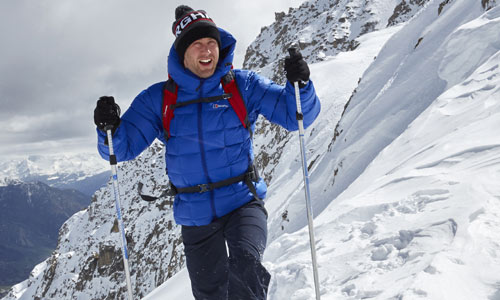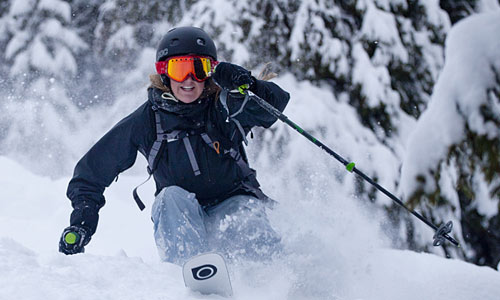How To Layer Yourself for Complete Protection Against The Snow!
Author

Chris shares his passion for cycling, hiking, skiing, and climbing from Buxton, in the Peak District. As a blogger for Outdoor Look, Chris shares outdoor tips and indoor tricks to help you get the most out of your time spent outside. When he's not out adventuring he's making videos or trying to keep up with his 4-year-old son.
Keeping oneself warm and dry in icy weather is extremely important. I learnt this the hard way last year, when I went for skiing with my friend without wearing appropriate clothing. While skiing on a hill, I fell down and some snow seeped into my garb, which later spread all over my body. Slowly, I felt myself fading and I was later diagnosed with hypothermia.

At that time, I learned about layering from veterans over there. They told me how inappropriately I was dressed and how lucky I was to recover well after getting hypothermia. Since then I have researched heavily, and I am proud to say that now I am quite an expert in finding the right layering solutions for myself and my family.
Your guide to warm comfort on a snowy excursion
First of all, I would like to clarify that layering is not for making a fashion statement. It is specifically needed for protection against cold and you need to know how your body reacts to cold before selecting your apparel. Generally I advise three layers, but for people who feel extremely cold when they go out in freezing conditions, the number of layers can be increased to four.
1. For the first layer, I recommend something made in silk, merino wool or polyester. These fabrics are not too heavy but still provide breathability, and have moisture-wicking property. By wearing this base layer, you will not only feel the warm comfort but also keep your body dry.
2. Second Layer may vary depending on your preference for 3 or 4 layers. This mid-layer should also have moisture-wicking capability along with breathability in the fabric. I wear polyester and merino wool pullovers myself as my mid-layers, and I recommend that you also opt for something similar.
 3. Third Layer should always be an insulating layer. If you are skiing in warm conditions or if you are wearing an insulated jacket, then you can avoid this layer. But if the weather is cold and windy, this layer will play a pivotal role in keeping you warm. Heat insulation stops the flow of heat from hotter to a colder body. Hence, this layer will help your body in keeping the heat accumulated in your first two layers and prevent it from escaping outside. If you are wearing an insulated pant as your final layer, then you do not need to buy additional insulating bottoms for layering.
3. Third Layer should always be an insulating layer. If you are skiing in warm conditions or if you are wearing an insulated jacket, then you can avoid this layer. But if the weather is cold and windy, this layer will play a pivotal role in keeping you warm. Heat insulation stops the flow of heat from hotter to a colder body. Hence, this layer will help your body in keeping the heat accumulated in your first two layers and prevent it from escaping outside. If you are wearing an insulated pant as your final layer, then you do not need to buy additional insulating bottoms for layering.
4. The task of layering is incomplete without the final layer. As you have the option to wear 3 or 4 layers according to your preference and surroundings, I would like to call it the final layer rather than the 4th layer. It is imperative that this layer should be at least highly water-resistant or completely waterproof, and breathable. This final layer may or may not be insulated but it needs to be easily removable, so that you can take it off as the temperature rises.
Wearing the right amount of layers made in the correct fabric is essential for a wonderful experience on snow. Be ready for cold weather with the right layers and ski with confidence, without worrying about the cold.
Author

Chris shares his passion for cycling, hiking, skiing, and climbing from Buxton, in the Peak District. As a blogger for Outdoor Look, Chris shares outdoor tips and indoor tricks to help you get the most out of your time spent outside. When he's not out adventuring he's making videos or trying to keep up with his 4-year-old son.
- Speed Up Your Post-Hike Recovery with These 6 Essential Tips
- Cycling through Tranquil Roads and Coastal Views on the Isle of Wight
- The Essential Guide to Hiking Safety: 5 Tips Every Hiker Should Know
- Run Smart, Run Strong: Your Guide to Injury-Free Running
- Embrace Biking: Essential Tips for Beginners
Categories
- Sport (28)
- Product Reviews (3)
- Team Outdoor Look (7)
- Mike Wild (2)
- Mike Payton (2)
- Suse Hammond-Pears (3)
- Snowboarding (12)
- Latest Offers (105)
- Shop Talk (1)
- Competitions (7)
- Walking (413)
- Lifestyle Fashion (8)
- Travel (86)
- Kit Guides (176)
- Workwear Clothing (6)
- Safety Workwear (4)
- Health/Fitness (289)
- Skiing (91)
- Great Outdoors (1316)
- Cycling (92)
- January 2025
- December 2024
- November 2024
- October 2024
- September 2024
- August 2024
- July 2024
- June 2024
- May 2024
- April 2024
- March 2024
- February 2024
- January 2024
- December 2023
- November 2023
- October 2023
- September 2023
- August 2023
- July 2023
- June 2023
- May 2023
- April 2023
- March 2023
- February 2023
- January 2023
- December 2022
- November 2022
- October 2022
- September 2022
- August 2022
- July 2022
- June 2022
- May 2022
- April 2022
- March 2022
- February 2022
- January 2022
- December 2021
- November 2021
- October 2021
- September 2021
- August 2021
- July 2021
- June 2021
- May 2021
- April 2021
- March 2021
- February 2021
- January 2021
- December 2020
- November 2020
- October 2020
- September 2020
- August 2020
- July 2020
- June 2020
- May 2020
- April 2020
- March 2020
- February 2020
- January 2020
- December 2019
- November 2019
- October 2019
- September 2019
- August 2019
- July 2019
- June 2019
- May 2019
- April 2019
- March 2019
- February 2019
- January 2019
- December 2018
- November 2018
- October 2018
- September 2018
- August 2018
- July 2018
- June 2018
- May 2018
- April 2018
- March 2018
- February 2018
- January 2018
- December 2017
- November 2017
- October 2017
- September 2017
- August 2017
- July 2017
- June 2017
- May 2017
- April 2017
- March 2017
- February 2017
- January 2017
- December 2016
- November 2016
- October 2016
- September 2016
- August 2016
- July 2016
- June 2016
- May 2016
- April 2016
- March 2016
- February 2016
- January 2016
- December 2015
- November 2015
- October 2015
- September 2015
- August 2015
- July 2015
- June 2015
- May 2015
- April 2015
- March 2015
- February 2015
- January 2015
- December 2014
- November 2014
- October 2014
- September 2014
- August 2014
- July 2014
- June 2014
- May 2014
- April 2014
- March 2014
- February 2014
- January 2014
- December 2013
- November 2013
- October 2013
- September 2013
- August 2013
- July 2013
- June 2013
- May 2013
- April 2013
- March 2013
- February 2013
- January 2013
- December 2012
- November 2012
- October 2012
- September 2012
- August 2012
- July 2012
- June 2012
- May 2012
- April 2012
- March 2012
- February 2012
- January 2012
- December 2011
- November 2011
- October 2011
- September 2011
- August 2011
- May 2010
- April 2010
- March 2010
- February 2010
- January 2010
- November 2009
- October 2009
- September 2009
Submit a Comment